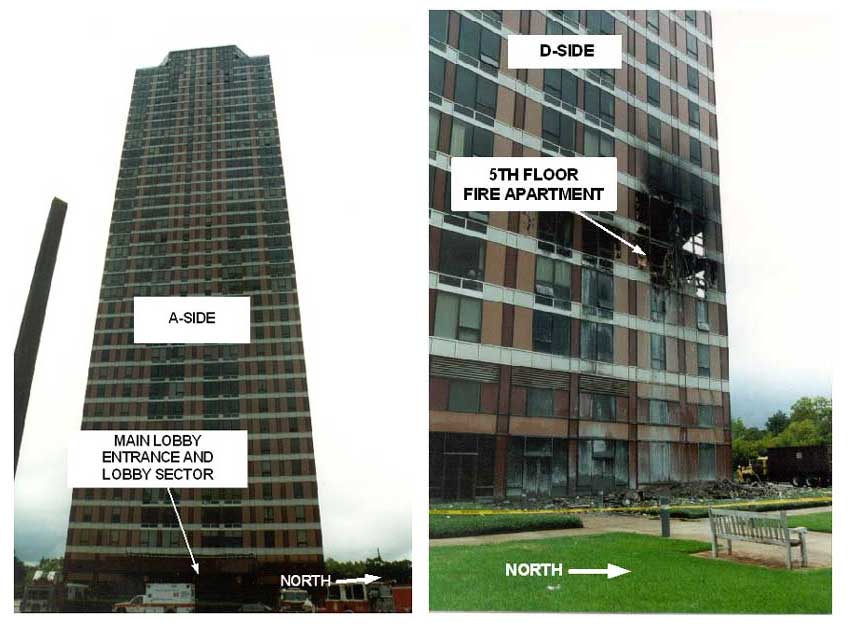

On Saturday, October 13, 2001, a fire in the a building at the Four Leaf Towers apartments in Houston, Texas, claimed the life of Houston (TX) Fire Captain Jay P. Jahnke.
Per the U.S. Fire Administration (USFA), Captain Jahnke, 40, and his engine company were dispatched to a report of a fire in the 40-story residential high-rise. Upon their arrival, Captain Jahnke reported a working fire on the fifth floor of the building and requested a second alarm. While Captain Jahnke’s driver attached lines to the building’s fire department connection, Captain Jahnke and his firefighter climbed the stairs to the fire floor.
Upon their arrival on the fire floor, Captain Jahnke and his firefighter were joined by the captain and firefighter from a ladder company. The four firefighters entered the fire occupancy and began to apply water to the fire. The two firefighters ran low on air and exited to change their cylinders, leaving the two captains to fight the fire. When the firefighters opened the stairway door to exit, conditions in the fire occupancy worsened dramatically. The captains decided to leave the apartment by following their hoseline but soon became separated.
Captain Jahnke became separated from the line and disoriented. The other captain was found in the stairwell by other firefighters and removed from the building. Captain Jahnke called for help on his portable radio. Firefighters responding to his request were guided to his location by the sound of his personal alert safety system (PASS) device. Despite their efforts, Captain Jahnke died of asphyxiation because of smoke inhalation.
RELATED
Houston Chronicle: High-rise fire kills two at 40-story apartment
Clay Magee: Standpipe Outlet Connections in High-Rise Buildings
State Fire Marshal’s Office Line of Duty Death Investigation: Captain Jay Jahnke (PDF)
Excerpted below is the National Institute for Occupational Safety and Health (NIOSH) report on the incident, F2001-33, which was released on October 21, 2002.
On October 13, 2001, a 40-year-old Captain (the victim) died and another Captain was injured while fighting a fifth floor high-rise apartment fire. At 0448 hours, units were dispatched to a fire alarm. Units arrived on the scene at 0453 hours and reported heavy fire showing from the exterior of the building. Crews made immediate entry and attack, but after running low on air the victim and the other Captain decided to exit. In the process, the victim apparently became disoriented and lost, whereas the other Captain was able to escape. Rescue crews were sent to the fifth floor where the victim was located in the elevator common area. The victim was transported to an area hospital where he was pronounced dead at 0615 hours. NIOSH investigators concluded that, to minimize the risk of similar occurrences, fire departments should
- ensure that the department’s high-rise Standard Operating Procedures (SOPs) are followed and refresher training is provided
- ensure that team continuity is maintained
- ensure that personnel are in position to maintain an offensive attack
- ensure that a lifeline is in place to guide fire fighters to an emergency stairwell
- instruct and train fire fighters on initiating emergency traffic (Mayday-Mayday) when they become lost, disoriented, or trapped
- ensure that a Rapid Intervention Team (RIT) is established and in position
- ensure that a backup line is manned and in position to protect exit routes
- ensure that adequate numbers of staff are available to immediately respond to emergency incidents
- ensure that the Incident Commander (IC) continuously evaluates the present weather conditions (i.e., high winds) during high-rise fire operations
Additionally,
- fire departments should establish and enforce standard operating procedures on the use of thermal imaging cameras for search-and-rescue operations
- the authority having jurisdiction shall ensure that the receipt and processing of alarms is completed in a timely manner
INTRODUCTION
On October 13, 2001, a 40-year-old Captain (victim) died and another Captain (Captain #1) was injured while fighting a high-rise apartment fire. The National Institute for Occupational Safety and Health (NIOSH) was notified of this incident by the U.S. Fire Administration (USFA) on October 16, 2001. On October 22, 2001, three Safety and Occupational Health Specialists and the Section Chief from the NIOSH Fire Fighter Fatality Investigation and Prevention Program investigated this incident. Meetings were conducted with the Chief, Assistant Chiefs, a District Chief, the department’s training officer, representatives of the City Fire and Arson Bureau, representatives of the International Association of Fire Fighters, and a representative from the Texas State Association of Fire Fighters. Interviews were conducted with officers and fire fighters involved in this incident. NIOSH investigators reviewed the fire department’s standard operating procedures (SOPs) for high-rise fire fighting, the fire department’s prefire plans for this building, witness statements, site diagrams, building floor plans and records, a National Climatic Data Center weather report for the time and area of the incident, dispatch tape transcripts, the medical examiner’s report, and the victim’s training records. A site visit was conducted and the incident site photographed.
The victim’s SCBA was sent to the NIOSH Respirator Branch in Morgantown, West Virginia, for further evaluation. The purpose of the testing was to determine the SCBA’s conformance to the approval performance requirements of Title 42, Code of Federal Regulations, Part 84 (42 CFR 84). Further testing was conducted to determine conformance to the National Fire Protection Association (NFPA) Air Flow Performance requirements of NFPA 1981, Standard on Open-Circuit Self-Contained Breathing Apparatus for the Fire Service, 1997 Edition. Seven performance tests were run, and the unit met the requirements of all tests except for the Remaining Service Indicator Test, where the Vibralert indicator activated prematurely. Even though the respirator failed this test, NIOSH investigators do not believe it was a contributing factor to this incident.
A follow-up visit was conducted on March 12, 2002, to interview additional officers and fire fighters involved in this incident. On April 12, 2002, a phone interview was conducted with the officer of Engine 11.

